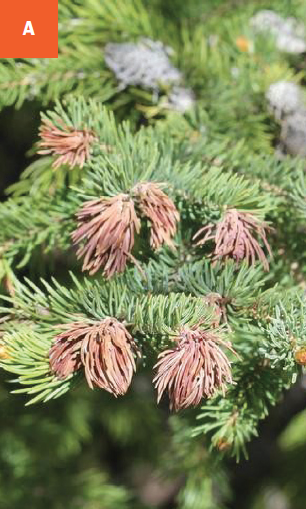Cooley Spruce Gall Adelgid
Adelges cooleyi
HOST Spruce, Douglas-fir
DAMAGE/SYMPTOMS Adelgids resemble aphids and form cone-like galls on the new growth of spruce trees. At the end of the summer, the galls resemble miniature pinecones.
LIFE CYCLE The insects use both Douglas-fir and spruce as hosts. On Douglas-fir, the adelgids overwinter as nymphs and mature in May. Some will disperse to spruce trees. On spruce, winged adelgids lay eggs which hatch in the spring around bud break. The nymphs move to the base of the needles to begin feeding. Gall formation occurs on spruce only, and the adelgids will continue to feed and develop within the galls.
MANAGEMENT The galls on spruce rarely harm the tree, and most trees have a high resistance to them. The damage on Douglas-fir is minimal. Once the galls have turned brown, the insects have already left the galls; removing them will not remove the insects or reduce future populations of the insects. For chemical control, a contact insecticide can be applied prior to gall formation or a systemic insecticide can be applied to the spruce tree in early spring.
A Galls on terminals of spruce. B Brown galls on terminals. C Developing galls.



